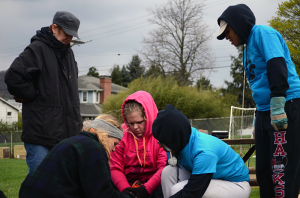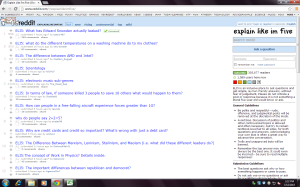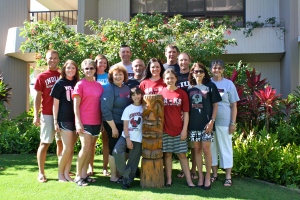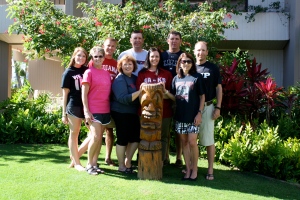
Photo credit – aprilbell, sxc.hu
When your boss is someone like Michele Papakie, you hear a lot of funny phrases. We have flyers posted in Command Central (410 Davis) that say “Can’t died in a cornfield!” and “Be the duck!” and “No! Try not! Do or do not, there is no try!” (Technically that last one isn’t a Papakieism, but it still makes me laugh.)
Michele also introduced me to the phrase “town and gown” which is apparently a popular way to describe the relationship between universities and their towns. I didn’t grow up in a college town, so I hadn’t heard the phrase until this year. If you’ve never heard it either, the community around a university is the “town” and the university people are the “gown.”
My first thought about the gowns were graduation gowns, but it actually goes back to the Middle Ages when European university students, who often acted as minor clerics, wore black robes similar to the clergy. This became the long black gown with a hood and cap that we think of when we picture scholars. The gowns were really helpful for students studying in unheated buildings, but they were also symbolic of the fact that academics did not perform physical labor. (Can you imagine trying to harvest crops dressed like Professor Snape?)
But the gowns also symbolically separated students and their teachers from the folks around them. Many university students didn’t speak the local dialects and the townspeople didn’t speak Latin, which made communication very difficult. And as universities gradually gained more and more independence from local control, the town began to resent and lose trust in the gown. Conflict and violence were rampant because each group was governed by separate bodies, each with its own priorities and loyalties.

IUP students volunteering at the Indiana Community Garden – Photo from The Penn
Flash forward to the modern-day United States: we don’t see a lot of violence between towns and universities, but it turns out that things aren’t exactly amazing, either. Universities believe their existence is key to the survival of the local economy; the surrounding towns claim institutions are robbing them of local tax revenue as universities expand and remove land property for local tax rolls, and universities aren’t taxable like other entities using town resources. Technically, universities don’t have to contribute anything to the town’s government, although some do.
Which brings me back to the Strategic Visioning Project and what got me thinking about the town/gown relationship. I first learned about this sticky situation when I facilitated a group interview last week at the community meeting of the Public Works committee at the borough. And I’m usually quick (maybe too quick, sometimes) to weigh in on a debate or propose a solution, but this is a tough one.
The borough receives no money from IUP and can’t tax the university, so maintenance and development projects are often underfunded or impossible. The borough manager said if IUP was a corporation, like IBM, the local government would be in great shape because of the tax revenue. But since IUP can’t be taxed and it doesn’t contribute funds to the borough, things aren’t so great financially.
On the other hand, IUP brings in nearly 15,000 students, effectively doubling the town’s population for much of the year. While students are here, we are employed by and patronize local businesses and contribute our time to area non-profits and through initiatives like Into the Streets.
Professors also contribute to the cultural and political landscape of the town — I’m thinking in particular of a handful of professors who are central to Indiana’s Center for Community Growth, which works to improve the livelihood of area residents by addressing social, economic, racial and environmental issues. But professors and students alike are also local business owners, entertainers and board members for a number of organizations.
It’s not like the borough doesn’t recognize this, either. Members of the Public Works committee noted the university’s contributions to the town, too. Without IUP, one said, Indiana would have remained a lower-class mining town.
The students and professors remain a strange mixture of town and gown, especially students like me who live off-campus, work in the town and rarely go home. We contribute a lot, but we’re also supported a lot by things like roads, sidewalks, recycling programs, facilities, parks and rec, law enforcement and fire departments, to name a few. And these things take money.
Which leaves the relationship where, exactly? Should IUP charge students a fee to provide the borough with the funding it needs for the town’s law enforcement and maintenance, much of which is directly tied to IUP in the first place? Should the borough work more closely with the university to begin meeting some of its professional needs while giving students internship opportunities?
The town and its center of learning do not have to be two separate entities, since each depends on the other for survival. Maybe things would have gone better back in the Middle Ages if the townspeople could have picked up some Latin and the scholars had invested more in the town and learned its language and ways. Or the academics could have tried taking off the gowns when they were outside the university. There’s no need for imaginary boundaries where none exist.
So I don’t know what the solution could be, and I’m excited to hear from people who have lived in this town their whole lives or for many generations. But I can tell you what won’t solve anything: cutting off communication between both parties and refusing to repair the relationship.
What are your thoughts on this issue? Please comment below.
– Emily Weber







